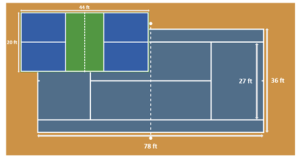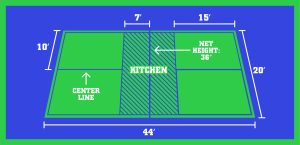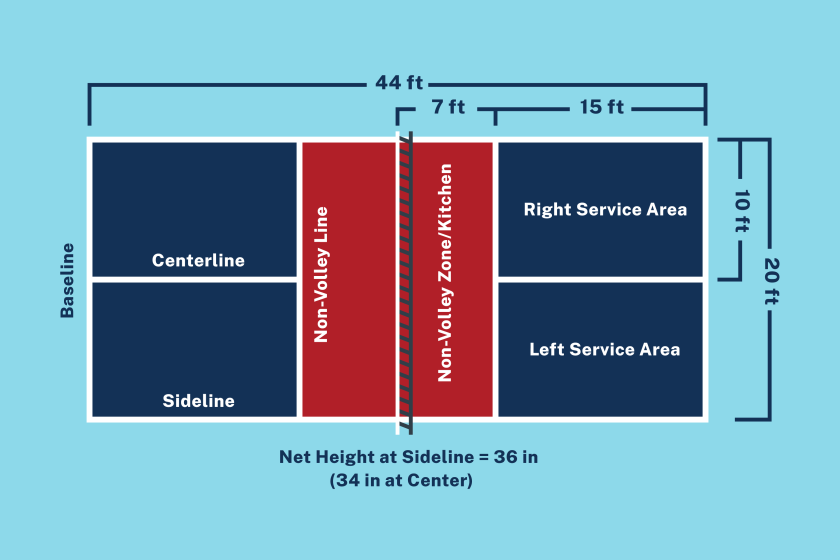Introduction
Pickleball, a fast-growing sport, combines elements of tennis, badminton, and table tennis. Whether you’re a beginner or a seasoned player, understanding the pickleball court dimensions is essential to enjoy the game to its fullest. In this comprehensive guide, we will explore the accurate dimensions of a pickleball court, the equipment required, and the rules governing the game. So let’s dive in and get ready to ace your pickleball skills!
How To Play Pickleball
To play pickleball, follow these basic guidelines:
- Equipment: You’ll need a pickleball paddle, which is similar to a larger table tennis paddle, and a perforated plastic ball (similar to a waffle ball). Find a pickleball court with the appropriate dimensions and a net set at the correct height.
- Setup: Divide the court into two halves with the net in the middle. Each half is further divided into two sections: the service area and the non-volley zone (kitchen).
- Serving: The game begins with one team serving the ball diagonally across the net. The server must stand behind the baseline and serve underhand, aiming to land the ball in the opponent’s service area. The serve must clear the non-volley zone.
- Return: The receiving team must let the served ball bounce before returning it. The ball must clear the net and land within the opposing team’s service area. The play continues with each team hitting the ball back and forth, allowing it to bounce once on each side.
- Non-Volley Zone: The non-volley zone (kitchen) is the area located near the net. You are not allowed to hit the ball in the air (volley) while standing inside this zone. However, you can enter the zone to play a ball that has bounced.
- Double Bounce Rule: After the serve and return, each team must allow the ball to bounce once before they can hit it in the air (volley). This is known as the double bounce rule and ensures that both teams have an opportunity to hit a groundstroke before volleying.
- Scoring: Pickleball can be played with either rally scoring or traditional scoring. In rally scoring, a point is awarded to the serving team for every rally won. In traditional scoring, only the serving team can score points.
- Rotation: In doubles play, players on the serving team rotate positions each time they win a point, with the server moving to the opposite side of the court.
- Faults: Various faults can occur during play, such as stepping into the non-volley zone while volleying or hitting the ball out of bounds. Faults result in the opposing team winning the rally and earning a point.
- Winning the Game: The game is typically played to 11 or 15 points, and the winning team must win by a margin of two points. Matches are usually the best of three games.

Remember, these are the basic rules of pickleball, and there may be additional rules and variations depending on the level of play and specific tournaments or events. Enjoy playing pickleball and have fun!
Pickleball Court Dimensions
The Pickleball Court Dimensions play a crucial role in determining the boundaries and the layout of the game. Pickleball is a popular racquet sport that combines elements of tennis, badminton, and table tennis. The dimensions of a pickleball court are slightly different from those of a tennis court. Understanding these dimensions is key to playing the game correctly and fairly. The official pickleball court dimensions are as follows:
- Length of the Court: The pickleball court is 44 feet long.
- Width of the Court: The pickleball court is 20 feet wide.
- Net Height: The net at the center of the court should be 36 inches high at the sidelines and 34 inches high at the center.
- Non-Volley Zone: The non-volley zone, commonly known as the “kitchen,” extends 7 feet from the net on both sides.
- Baseline and Sideline: The baseline is the back boundary of the court, and the sideline marks the side boundaries.
Equipment Required for Pickleball
To enjoy pickleball, you need a few essential pieces of equipment. Here’s what you’ll need:
- Pickleball Paddle: The paddle is used to hit the ball. It is slightly larger than a ping-pong paddle and is usually made of composite or graphite materials.
- Pickleball: The ball used in pickleball is similar to a waffle ball but slightly smaller and with fewer holes. It is designed to provide a good bounce and optimal playability.
- Pickleball Court: A pickleball court can be set up indoors or outdoors. It should meet the official dimensions and be properly marked.
- Pickleball Net: The net divides the court into two sides. It should be sturdy and set at the correct height.
Rules of Pickleball
To ensure fair play and an enjoyable experience, pickleball has specific rules that players must follow. Here are some key rules to keep in mind:
- Serve: The serve must be made diagonally cross-court and cleared below the waist. The server continues serving until they commit a fault.
- Double Bounce Rule: After the service, each team must allow the ball to bounce once on each side before volleying. This rule promotes longer rallies and strategic play.
- Non-Volley Zone Rule: In the non-volley zone, also known as the kitchen, players are not allowed to hit the ball out of the air. They must let it bounce before playing it.
- Scoring: Points are only scored by the serving team. Games are typically played to 11 points, and players must win by a margin of 2 points.
- Faults: Faults occur when a player violates a rule, such as stepping into the non-volley zone or hitting the ball out of bounds. Faults result in the opposing team gaining a point.

Frequently Asked Questions (FAQs)
- Q: Are the pickleball court dimensions the same for singles and doubles play? A: Yes, the court dimensions remain the same for both singles and doubles play. The only difference lies in the positioning of the players on the court.
- Q: Can pickleball courts be adjusted for recreational play in smaller spaces? A: Yes, pickleball courts can be modified to fit smaller spaces. By using temporary court lines or portable nets, you can create a smaller playing area while maintaining proportional dimensions.
- Q: What happens if the ball hits the net during a serve? A: If the ball hits the net and lands within the proper serving area, it is considered a “let” serve and can be retaken without any penalties. However, if the ball hits the net and lands out of bounds, it is considered a fault.
- Q: Are there specific rules for serving in pickleball? A: Yes, there are specific rules for serving. The serve must be made diagonally cross-court, and the server must keep one foot behind the baseline until the ball is struck. Additionally, the server must be hit below the waist.
- Q: Can players enter the non-volley zone to hit the ball? A: Yes, players are allowed to enter the non-volley zone, but they must ensure that both feet are behind the line before hitting the ball. Stepping into the non-volley zone while hitting the ball results in a fault.
- Q: Can pickleball courts be used for other sports? A: While pickleball courts are specifically designed for pickleball, they can also be used for other sports such as badminton or modified tennis. The dimensions and layout of the court allow for versatility in recreational activities.
Conclusion
Understanding the pickleball court dimensions is vital for both beginners and experienced players. By adhering to the official dimensions, players can enjoy a fair and competitive game. Remember to equip yourself with the necessary gear, follow the rules of play, and practice good sportsmanship. Whether you’re playing for recreation or in a competitive setting, pickleball offers an exciting and engaging experience for all. So gather your gear, find a court, and enjoy the thrill of pickleball!




![10 Best Carrom Board Brands in India [year]: A Comprehensive Guide best carrom board brands in India](https://top10collections.com/wp-content/uploads/2020/04/best-carrom-board-brands-in-india.png)
